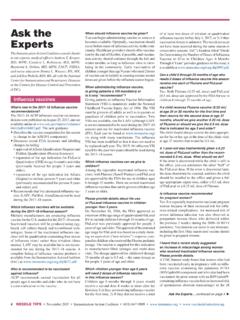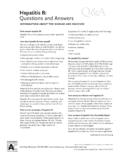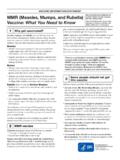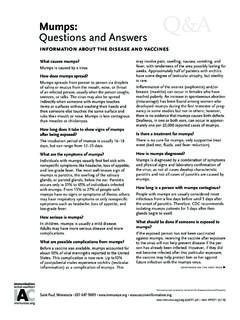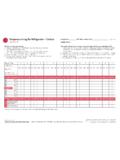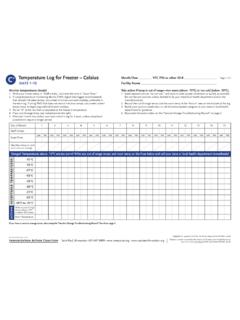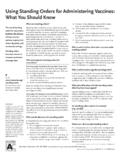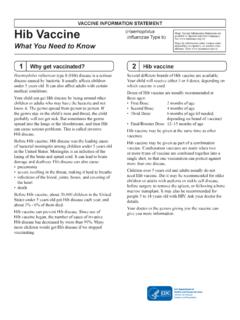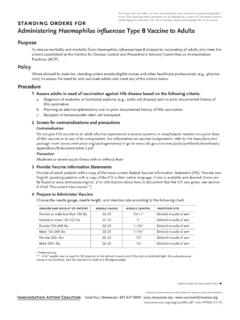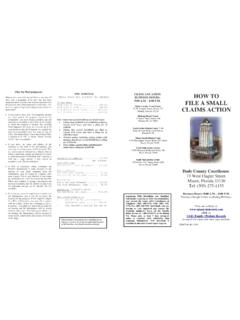Transcription of Measles: Questions and Answers - immunize.org
1 Technical content reviewed by the Centers for Disease Control and PreventionSaint Paul, Minnesota 651-647-9009 Item #P42 09 (4/15)What causes measles? Measles is caused by a virus. How does measles spread? Measles is spread from person to person through the air by infectious droplets; it is highly long does it take to show signs of measles after being exposed? It takes an average of 10 12 days from exposure to the first symptom, which is usually fever. The measles rash doesn t usually appear until approximately 14 days after exposure, 2 3 days after the fever are the symptoms of measles? Symptoms include fever, runny nose, cough, loss of appetite, pink eye, and a rash. The rash usually lasts 5 6 days and begins at the hairline, moves to the face and upper neck, and proceeds down the body. How serious is measles? Measles can be a serious disease, with 30% of reported cases experiencing one or more complica-tions.
2 Death from measles occurs in 2 to 3 per 1,000 reported cases in the United States. Complications from measles are more common among very young children (younger than five years) and adults (older than 20 years). What are possible complications from measles? Diarrhea is the most common complication of measles (occurring in 8% of cases), especially in young children. Ear infections occur in 7% of reported cases. Pneumonia, occurring in 6% of reported cases, accounts for 60% of measles-related deaths. Approximately one out of one thousand cases will develop acute encephalitis, an inflammation of the brain. This serious complication can lead to perma-nent brain damage. Measles during pregnancy increases the risk of premature labor, miscarriage, and low-birth-weight infants, although birth defects have not been linked to measles exposure. Measles can be especially severe in persons with compromised immune systems.
3 Measles is more severe in malnourished children, particularly those with vitamin A deficiency. In developing countries, the fatality rate may be as high as 25%.How is measles diagnosed? Measles is diagnosed by a combination of the patient s symptoms and by laboratory tests. Is there a treatment for measles? There is no specific treatment for measles. People with measles need bed rest, fluids, and control of fever. Patients with complications may need treat-ment specific to their problem. How long is a person with measles contagious? Measles is highly contagious and can be transmitted from four days before the rash becomes visible to four days after the rash appears. What should be done if someone is exposed to measles? Notification of the exposure should be communicated to a doctor. If the person has not been vaccinated, measles vaccine may prevent disease if given within 72 hours of exposure.
4 Immune globulin (a blood product containing antibodies to the measles virus) may prevent or lessen the severity of measles if given within six days of exposure. How common is measles in the United States? Before the vaccine was licensed in 1963, there were an estimated 3 4 million cases each year. In the years following 1963, the number of measles cases dropped dramatically with only 1,497 cases in 1983, the lowest annual total reported up to that time. By 2004, only 37 cases were reported a record low. However, new cases continued to be reported, pri-marily in populations that have refused vaccination for religious or personal belief reasons. From 2001 through 2011, an average of 63 measles cases (range, 37 to 220) and four outbreaks were reported each Q&AMeasles: Questions and Answersinformation about the disease and vaccinescontinued on the next page year in the United States.
5 Of the 911 cases, a total of 372 (41%) were imported from outside the and an additional 432 (47%) were associated with importations. Hospitalization was reported for 225 (25%) cases. Two deaths were reported. Most cases occur among people who declined vaccination because of a religious, or personal experienced a record number of measles cases during 2014, with 644 cases reported from 27 states. This is the greatest number of cases since measles elimination was documented in the in 2000. In 2015, the is currently experiencing a large, multi-state outbreak of measles linked to an amusement park; for up-to-date case counts and outbreak information (updated on Mondays), visit CDC s Measles Cases and Outbreaks web page at someone get measles more than once? did vaccines for measles, mumps, and rubella become available? The first measles vaccines (an inactivated and a live virus product) became available in 1963, both of which were largely replaced by a further attenu-ated live virus vaccine that was licensed in 1968.
6 The mumps vaccine first became available in 1967, followed by the rubella vaccine in 1969. These three vaccines were combined in 1971 to form the measles-mumps-rubella (MMR) vaccine. A vaccine that combines both MMR and varicella (chickenpox) vaccines, known as MMRV, became available in 2005. Single antigen measles, mumps, and rubella vaccines are no longer available in the What kind of vaccine is it? MMR vaccine contains live, attenuated (or weakened) strains of the measles, mumps, and rubella viruses. How is this vaccine given? This vaccine is a shot given subcutaneously (in the fatty layer of tissue under the skin). Who should get this vaccine? All children, adolescents, and adults born in 1957 or later without a valid contraindication should have documentation of vaccination or other evidence of immunity. Additionally, some healthcare personnel who were born before 1957 may also need proof of vaccination or other evidence of immunity.
7 What kind of evidence of immunity can substitute for MMR vaccination? Evidence of immunity can be shown by having labo-ratory evidence of immunity to measles, mumps, and/or rubella or laboratory confirmation of disease. However, if a person doesn t have evidence of immu-nity to all three diseases ( , measles, mumps, and rubella), they would still need to get vaccinated with MMR since the vaccine is not available as a single antigen product in the At what age should the first dose of MMR be given? The first dose of MMR should be given on or after the child s first birthday; the recommended age range is from 12 15 months. A dose given before 12 months of age will not be counted, so the child s medical appointment should be scheduled with this in mind. When should children get the second MMR shot? The second dose is usually given when the child is 4 6 years old, or before he or she enters kindergarten or first grade.
8 However, the second dose can be given earlier as long as there has been an interval of at least 28 days since the first effective is this vaccine? The first dose of MMR produces immunity to measles and rubella in 90% to 95% of recipients. The second dose of MMR is intended to produce immunity in those who did not respond to the first dose, but a very small percentage of people may not be protected even after a second dose. Which adolescents and adults should receive the MMR vaccine? All unvaccinated adolescents without a valid contra-indication to the vaccine should have documentation of two doses of MMR. All adults born in or after 1957 should also have documentation of vaccination or other evidence of action Coalition Saint Paul, Minnesota 651-647-9009 Item #P42 09 (4/15)continued on the next page Measles: Questions and Answers (continued) page 2 of 4 Measles: Questions and Answers (continued) page 3 of 4 Immunization action Coalition Saint Paul, Minnesota 651-647-9009 Item #P42 09 (4/15)Adults born before 1957 are likely to have had measles and/or mumps disease as a child and are generally (but not always) considered not to need vaccination.
9 Which adults need two doses of MMR vaccine? Certain adults are at higher risk of exposure to mea-sles, mumps, and/or rubella and may need a second dose of MMR unless they have other evidence of immunity; this includes adults who are: students in postsecondary educational institutions (for measles and mumps) healthcare personnel (for measles and mumps) living in a community experiencing an outbreak or recently exposed to the disease (for measles and mumps) planning to travel internationally (for measles and mumps) people who received inactivated (killed) measles vaccine or measles vaccine of unknown type during 1963 1967 should be revaccinated with two doses of MMR vaccine. people vaccinated before 1979 with either killed mumps vaccine or mumps vaccine of unknown type who are at high risk for mumps infection ( , persons who are working in a healthcare facility) should be considered for revaccination with 2 doses of MMR do healthcare personnel need vaccination or other evidence of immunity to measles, mumps, and rubella?
10 People who work in medical facilities are at much higher risk for being exposed to disease than is the general population. Making sure that all employees are immune to these diseases protects both the employee and the patients with whom he or she may have contact. All people working in a healthcare facility in any capacity should have documentation of vaccination or evidence of immunity, including full- or part-time employees, medical or non-medical, paid or volunteer, students, and those with or without direct patient should consider vaccinating with MMR vaccine healthcare personnel born before 1957 who lack laboratory evidence of measles, mumps, and rubella immunity or laboratory confirmation of previous disease. These facilities should vaccinate healthcare personnel with MMR during an outbreak of any of the diseases, regardless of birth year. Who recommends this vaccine?
